- News
- Reviews
- Bikes
- Accessories
- Accessories - misc
- Computer mounts
- Bags
- Bar ends
- Bike bags & cases
- Bottle cages
- Bottles
- Cameras
- Car racks
- Child seats
- Computers
- Glasses
- GPS units
- Helmets
- Lights - front
- Lights - rear
- Lights - sets
- Locks
- Mirrors
- Mudguards
- Racks
- Pumps & CO2 inflators
- Puncture kits
- Reflectives
- Smart watches
- Stands and racks
- Trailers
- Clothing
- Components
- Bar tape & grips
- Bottom brackets
- Brake & gear cables
- Brake & STI levers
- Brake pads & spares
- Brakes
- Cassettes & freewheels
- Chains
- Chainsets & chainrings
- Derailleurs - front
- Derailleurs - rear
- Forks
- Gear levers & shifters
- Groupsets
- Handlebars & extensions
- Headsets
- Hubs
- Inner tubes
- Pedals
- Quick releases & skewers
- Saddles
- Seatposts
- Stems
- Wheels
- Tyres
- Health, fitness and nutrition
- Tools and workshop
- Miscellaneous
- Buyers Guides
- Features
- Forum
- Recommends
- Podcast
feature
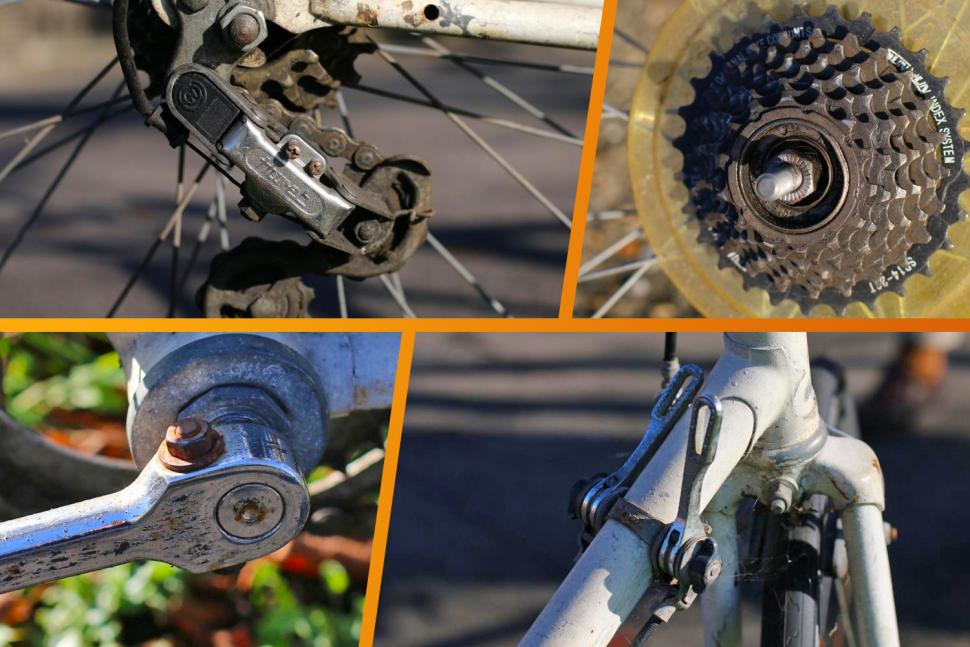 8 bike technologies we're well rid of Nov 2022
8 bike technologies we're well rid of Nov 20228 bygone bike technologies we're now well rid of
Browse bike ads on eBay and Facebook Marketplace and you’ll see a lot of ‘vintage’ bikes and half-finished ‘projects’ featuring archaic bike parts that have all but vanished from mainstream cycling use — for good reasons. Here are eight dubious and archaic features that you should swerve if you’re shopping for a second hand bike...
Cottered cranks
A cottered crank is held on to the axle by a shaped bolt called a cotter pin. The axle is mostly round with a section at the end where the crank sits. The cotter pin has a matching flat side, cut at an angle. The pin goes through the crank and when you tighten its nut that clamps the crank against the axle.
> How to fit new cranks to your bike
Problem number one with the design is that the cotter pin has to be extremely tight — it’s better to hammer or press it into place rather than just relying on the nut — which makes it difficult to remove to maintain the bottom bracket. Problem number two is that for the whole assembly to fit together really well, the cotter pin should be filed to fit snugly against the axle, which is a whole other pile of hassle.
Cotter pins were made obsolete by aluminium cranks with square taper axles, which were lighter and easier to fit, though a couple of companies actually made aluminium cottered cranks.
Suicide levers
Cheap road bikes often used to come fitted with these ‘safety’ brake extension levers that made it possible to brake from the tops. But they often reduced the possible lever travel because they slotted into the regular brake levers and being a long bit of flappy aluminium they were really flexible. The practical upshot was that they’d bottom out on the handlebar if your brakes weren’t perfectly adjusted — and how many cheap bikes ever had perfectly adjusted brakes?
Amazingly, you can still buy them, but this link is provided only for amusement; please don’t. Instead, if you want to be able to brake from the tops, get cyclo-cross style ‘interrupter’ levers (shown above) that clamp to the handlebar.
Steel rims
Not even the most ardent member of the Ferrous Tendency (motto: “Steel is real”) wants to see the return of chromed steel wheel rims. Not only were they heavy and prone to rust if the chrome got scratched, but they were hopeless if you needed to slow down in the rain.
Wet chromed steel is very slippery and rubber brake blocks just don’t get any purchase on it. Braking on a bike with steel rims is therefore a matter of waiting till the brakes have rubbed all the water off the rim, and hoping that happens before you hit something. Leather-faced brake blocks help, but just swapping the wheels out for aluminium ones is a far better idea.
The only current bikes I can find with steel rims are deliberately retro-styled roadsters with rod brakes. EU and UK standards dictate how well brakes have to work, including when wet, and you have to wonder how such bikes meet the standards — or even if they do.
Screw-on freewheels
There was a time when your rear wheel sprockets sat on a ratcheting mechanism that was separate from the rear hub and screwed into place. There were several problems with this design, ranging from irritating to actually dangerous.
The worst was that a threaded hub had a significant length of unsupported axle between the bearings and the frame, which often led to bent or even broken axles. That became more and more of a problem as gearing grew to six and seven sprockets. By moving the drive-side bearing much closer to the dropout, Shimano’s freehub design solved the problem and eventually led to the 11, 12 and even 13-sprocket hubs we have now.
> Where cycling products go to die: bike tech that didn't catch on
If the threads of a screw-on freewheel aren’t greased on assembly they can seize on the hub; they’re usually steel, the hub’s aluminium and bimetallic corrosion is your sworn enemy. Yes, this is preventable, but if it happened removing a screw-on freewheel was often made more difficult by the removal tool. These often had a pair of dogs that engaged with notches in the freewheel body. Both dogs and notches were fragile and often broke.
Screw-on freewheels have never quite gone away though; you still find them on some budget bikes. Thankfully, every multiple-sprocket screw-on freewheel I’ve seen recently used Shimano’s splined remover, the same pattern as their cassette lockrings.
Annoyingly, screw-on freewheels have started creeping back on bikes with four-figure price tags, because they’re used on e-bikes with hub motors. These hubs often have huge axles that only just fit through the freewheel body, so you need a special, ultra-thin tool to remove them.
Down tube levers
I think Shimano’s introduction of combined brake and shift levers in 1990 paved the way for the MAMIL cycling boom of the 2000s and beyond. One of the things that often made new riders nervous about road bikes was having to take a hand off the bars to reach down and change gear. Putting shifting control into the brake levers fixed that problem.
Someone will comment that down tube levers are fine when you get used to them, because you develop muscle memory for where they’re positioned. That’s true — but irrelevant, because we’re talking about first impressions here, and for many riders that first impression was ‘this is difficult’.
One answer was to put shift levers up on the handlebar stem, where they lurked ready to stab you in the vitals if you crashed. That’s a bad idea that still hasn’t been completely hounded out of existence.
I started cycling in the days when down tube levers were the only type of gear lever, but these days you’ll take my combined brake/shifter levers out of my cold dead hands — and can you imagine gravel bikes with down tube levers?
Huret Eco and other straight parallelogram derailleurs
Every modern derailleur owes its basic operation to the Campagnolo 1951 Gran Sport mechanism, which used an articulating parallelogram to move a jockey wheel across the sprockets. Campagnolo wasn’t the first.
A French company, Nivex, made a parallelogram derailleur in the 1930s, but it was rather swamped by the vast range of derailleur designs at the time, and racers of the 1930s mistakenly believed its two pulleys added excessive friction to the transmission.
The Gran Sport might not have been first, but it was tough, mechanically simple and worked well compared to other derailleurs of the era. It was a roaring success.
The Gran Sport spawned scores of clones from companies you might have heard of such as Shimano and Mavic, and from many that are long gone like Zeus, Simplex, and Galli. There were even Soviet derailleurs such as Tectoron and Kharvov.
But the most commercially successful of them all was the Huret Eco, which was ubiquitous on cheap road bikes from the late 1970s until some time in the late 80s or early 90s. It’s hard to determine when production of the Eco ceased because, unlike product introductions, product death doesn’t usually come with a marketing fanfare. Huret was later bought by Sachs and it’s possible the Eco limped along until SRAM bought Sachs in 1997.
Straight parallelogram derailleurs like the Eco (and even the Campagnolo versions, however nicely they were made) don’t generally shift very well because they end up with a big length of laterally flexible chain between the top jockey wheel and smaller sprockets. Even the cheapest modern derailleurs, like the Shimano Tourney, shift better thanks to subtle tweaks in their geometry.
As well as not shifting very well, the Eco had a tendency to seize up if it wasn’t maintained. Its sole advantage was that being made of pressed steel and rivets, it was very, very cheap. The domination of Shimano and the availability of better-functioning alternatives killed it off.
Galvanised and chromed spokes
You coat steel in zinc to stop it rusting; your granny probably had a zinc-coated steel dustbin. Unfortunately low-grade steel that needs galvanising to stop it rusting also tends to have a short life if you repeatedly load and unload it, which is exactly what happens to spokes. Galvanised ‘rustless’ spokes therefore can fail by metal fatigue after just a few hundred miles.
Stainless steel has much better resistance to metal fatigue, which is why anyone trying to build wheels with reasonable durability uses stainless spokes.
There was also a vogue for chrome-plated spokes, which were very shiny and looked amazing on a sunny day. Unfortunately, chromium-plating steel can make it brittle, which is a property you really don’t want in a spoke, so their fatigue life was poor, and the chrome would rub off at the spoke crossings, allowing for unsightly rust.
Wingnuts
“Something must change in the rear.”
According to legend, that’s what Tullio Campagnolo said to himself after losing a race because of wingnuts. The story goes that in the 1920s Campagnolo, at the time a talented amateur racer, was in a small lead group in the late-season Gran Premio della Vittoria. The weather was foul and Campagnolo’s hands were so cold he was unable to undo the wingnuts that held his rear wheel in place.
Depending on which version of the story you go for, Campagnolo either had a puncture or needed to change gear for the climb of the Croce d’Aune pass. At the time racers eschewed derailleurs and you changed from high to low gear by flipping the wheel to use the larger sprocket.
Faffing with frozen fingers, Campagnolo lost his spot in the lead group; and muttering “something must change in the rear” to himself, headed for his workshop in his father’s hardware store to consign wingnuts to the dustbin of history by inventing the quick-release hub.
As well as being hard to operate with cold hands, wingnuts are difficult to get properly tight if you don't have lots of hand strength. Bolt-up wheels still exist but use 15mm nuts that you tighten with a spanner usually about 15cm long. That gives a lot more leverage to get it properly tight than can be attained with wings less than 5cm long.
Incidentally, it’s possible the famed GP della Vittoria incident never happened. For a start, nobody seems to be able to agree if it happened in 1924 or 1927. Derailleur historian Frank Berto gives both years in The Dancing Chain.
Jan Heine of Bicycle Quarterly writes that his researchers — including David Herlihy, author of Bicycle: The History — have been unable to find any contemporary reference to Campagnolo taking part in the GP della Vittoria, or of Campagnolo’s claimed 1930 patent on the quick-release.
Let us know your 'favourite' cycling tech fails from yesteryear in the comments below
John has been writing about bikes and cycling for over 30 years since discovering that people were mug enough to pay him for it rather than expecting him to do an honest day's work.
He was heavily involved in the mountain bike boom of the late 1980s as a racer, team manager and race promoter, and that led to writing for Mountain Biking UK magazine shortly after its inception. He got the gig by phoning up the editor and telling him the magazine was rubbish and he could do better. Rather than telling him to get lost, MBUK editor Tym Manley called John’s bluff and the rest is history.
Since then he has worked on MTB Pro magazine and was editor of Maximum Mountain Bike and Australian Mountain Bike magazines, before switching to the web in 2000 to work for CyclingNews.com. Along with road.cc founder Tony Farrelly, John was on the launch team for BikeRadar.com and subsequently became editor in chief of Future Publishing’s group of cycling magazines and websites, including Cycling Plus, MBUK, What Mountain Bike and Procycling.
John has also written for Cyclist magazine, edited the BikeMagic website and was founding editor of TotalWomensCycling.com before handing over to someone far more representative of the site's main audience.
He joined road.cc in 2013. He lives in Cambridge where the lack of hills is more than made up for by the headwinds.
Latest Comments
- mikewood 18 min 40 sec ago
I think all new housing developments should be forced to do exactly that. They already do the LTN type thing. And cyclists do ride past it, I have!...
- Rendel Harris 24 min 20 sec ago
Have you had your cranks checked under the Shimano recall scheme? I ask because I took Mrs H's 2016 Roubaix into the LBS for the free check on her...
- Andski808 12 min 17 sec ago
True, but it applies to equally to all sorts of branded products - cars, kettles, phones etc...
- David9694 1 hour 12 min ago
Car crashes into front of home in Briggs Mead, Wymondham...
- nowasps 1 hour 23 min ago
I've worked my way through a gifted box of these, and the review tallies exactly with my own experience.
- E6toSE3 1 hour 54 min ago
Quite wrong. The really interesting stuff was good goggles for under £80 - my budget and I was previously limited to Tifosi. Had to ask about...
- Haitchaitch 3 hours 11 min ago
I concur that rigid bollards can be a danger having broken a couple of ribs earlier this year in a shared cycle lane with central bollards telling...
- quiff 4 hours 24 min ago
Definitely recognise this! I'm 41 with a 5 year old and am now starting to see the possibility of riding more again, but Strava tells me I have...
- brooksby 4 hours 58 min ago
"No, it's OK, really", replies cycling.
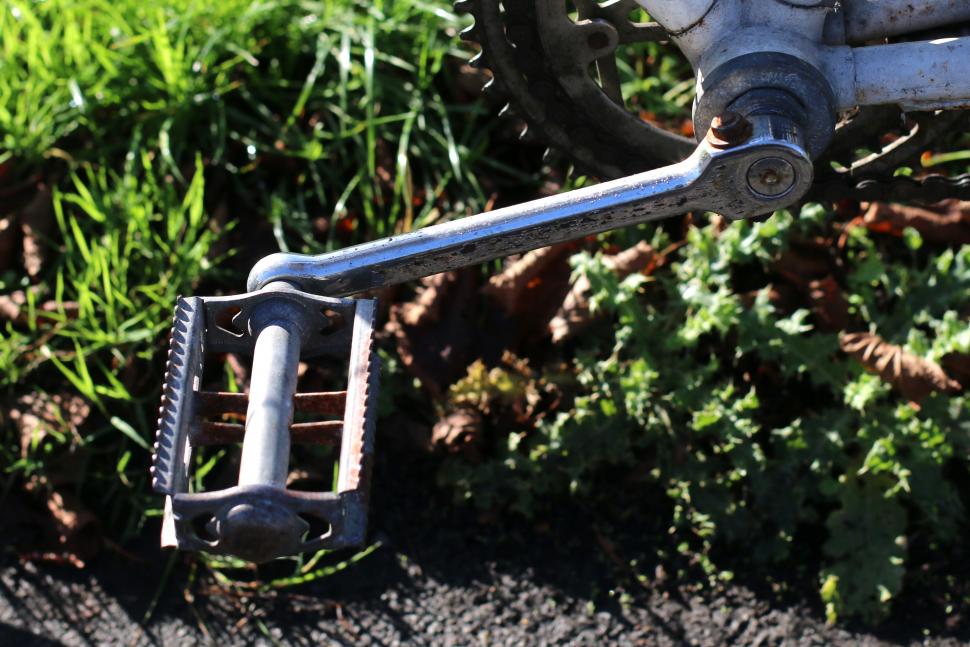
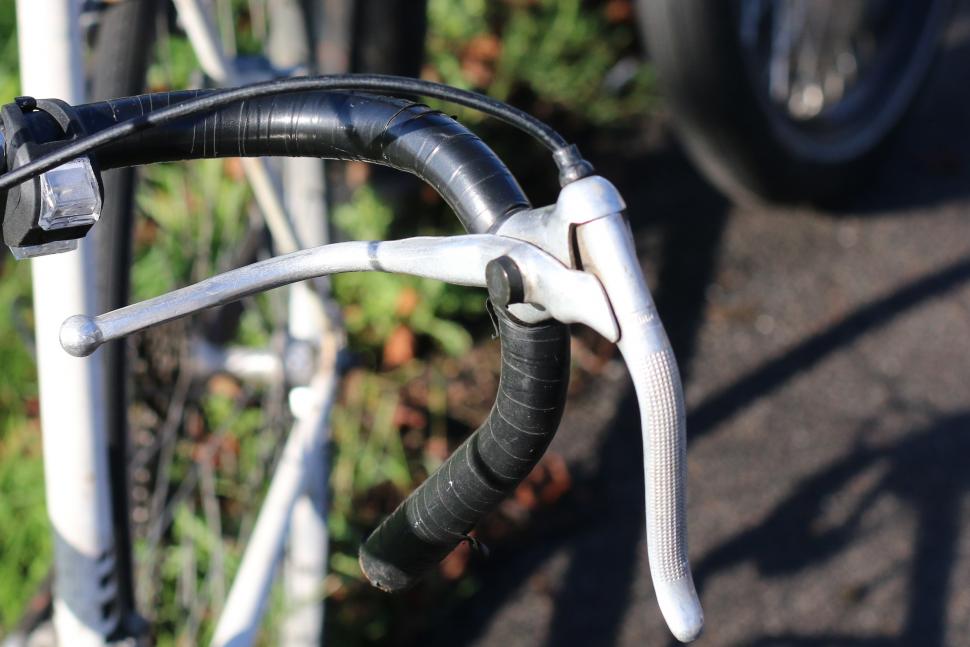
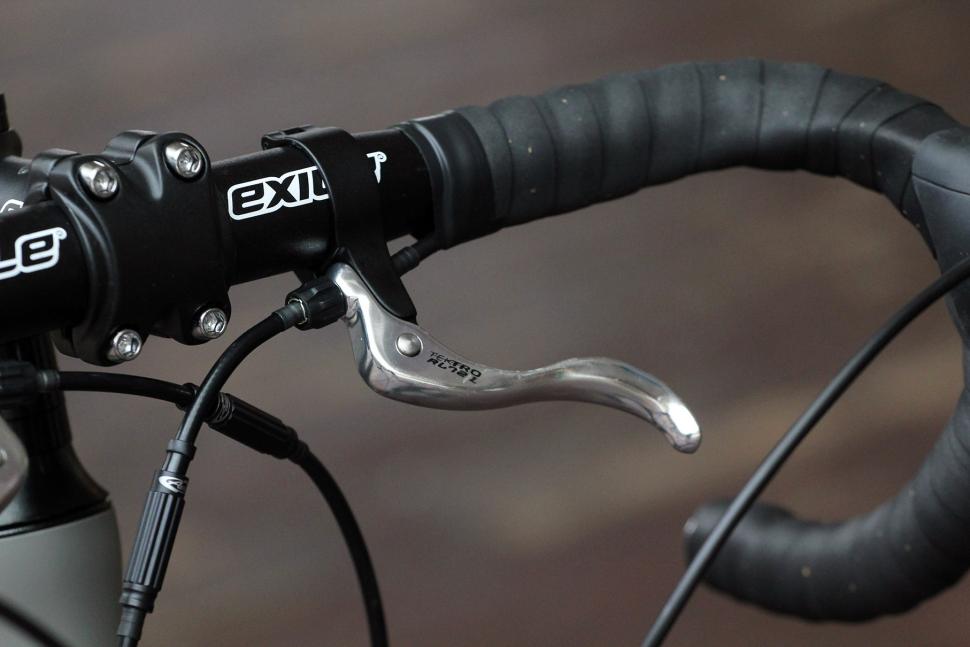
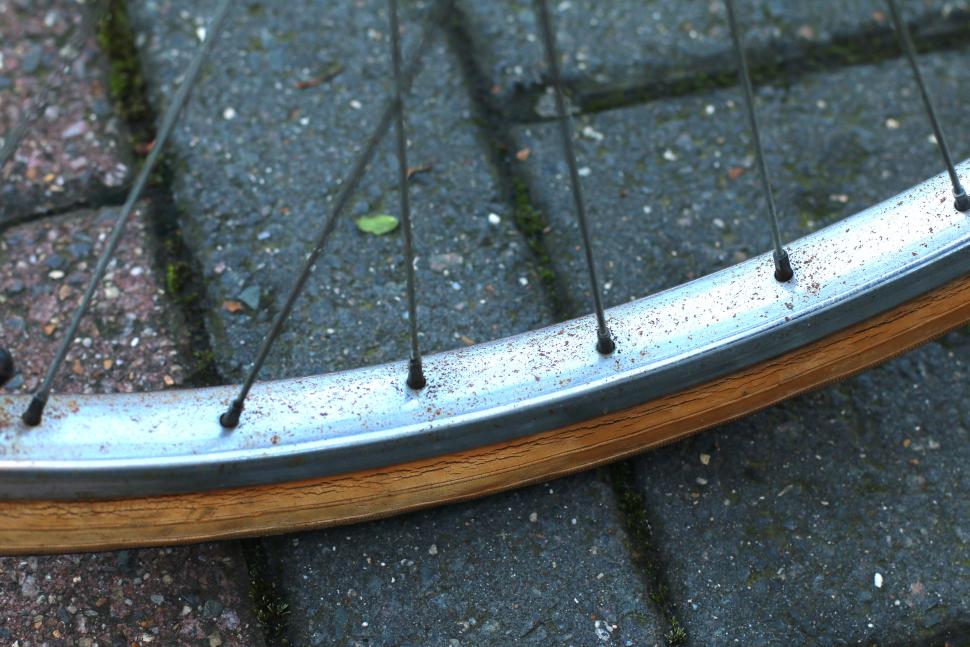
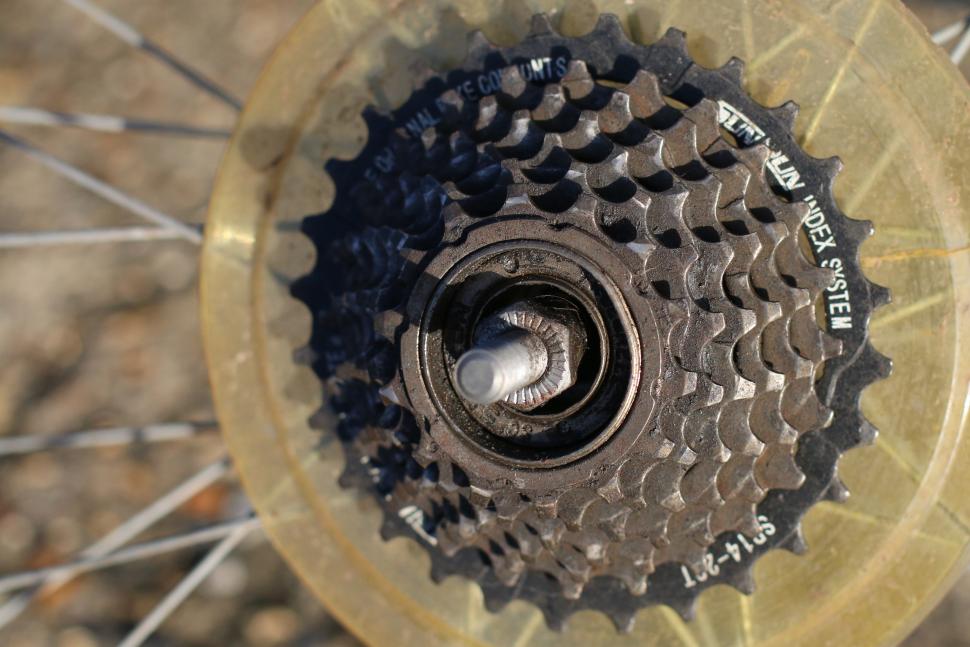
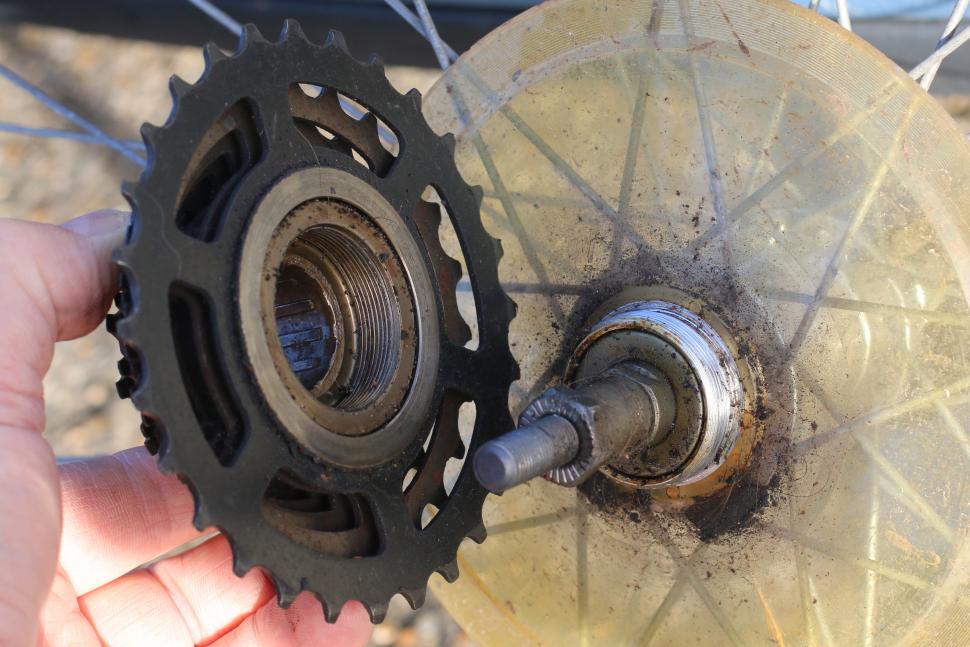
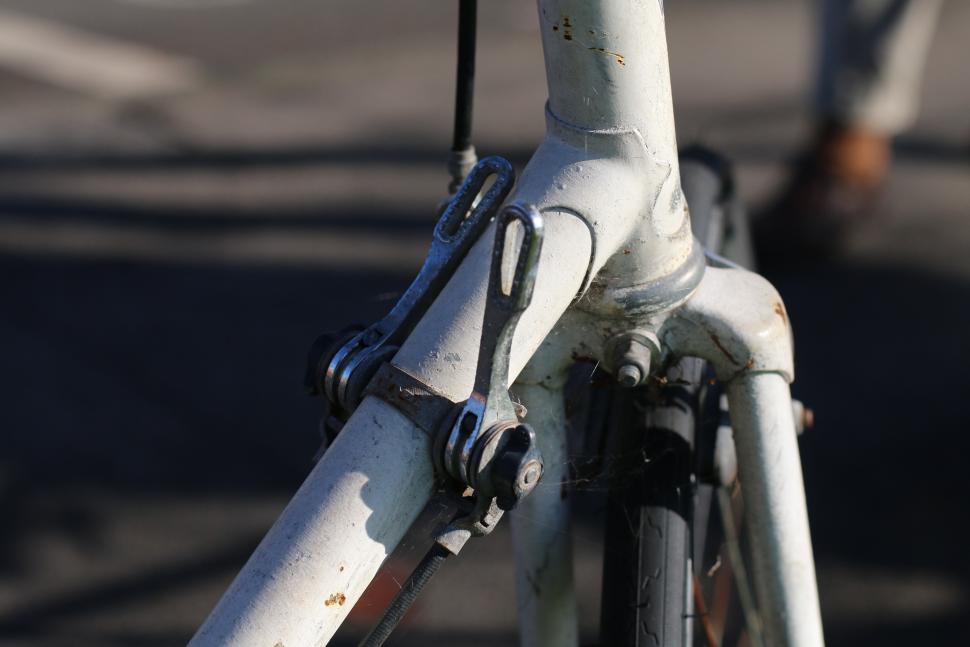
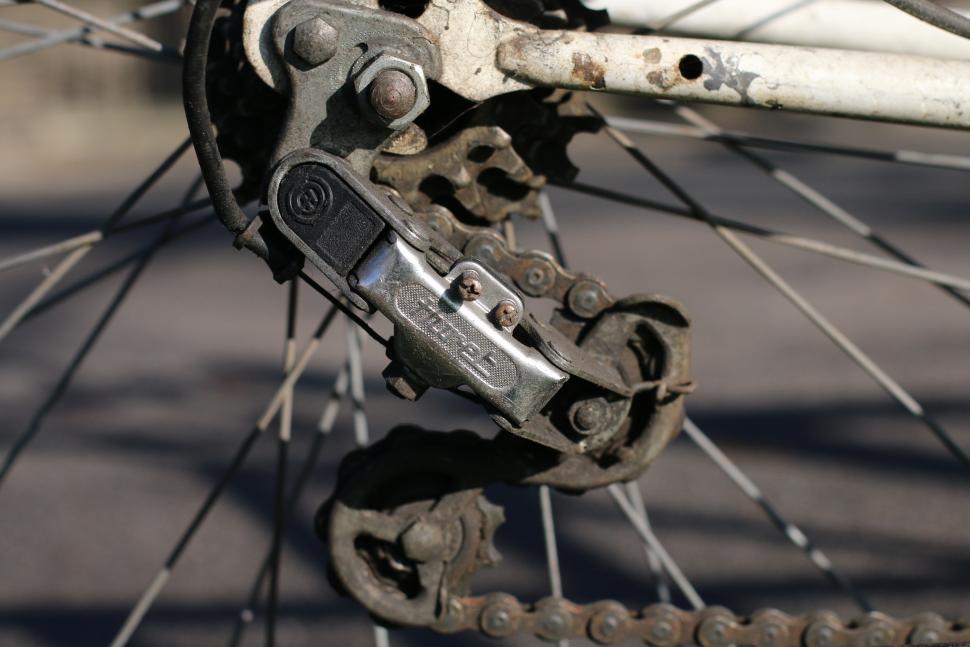

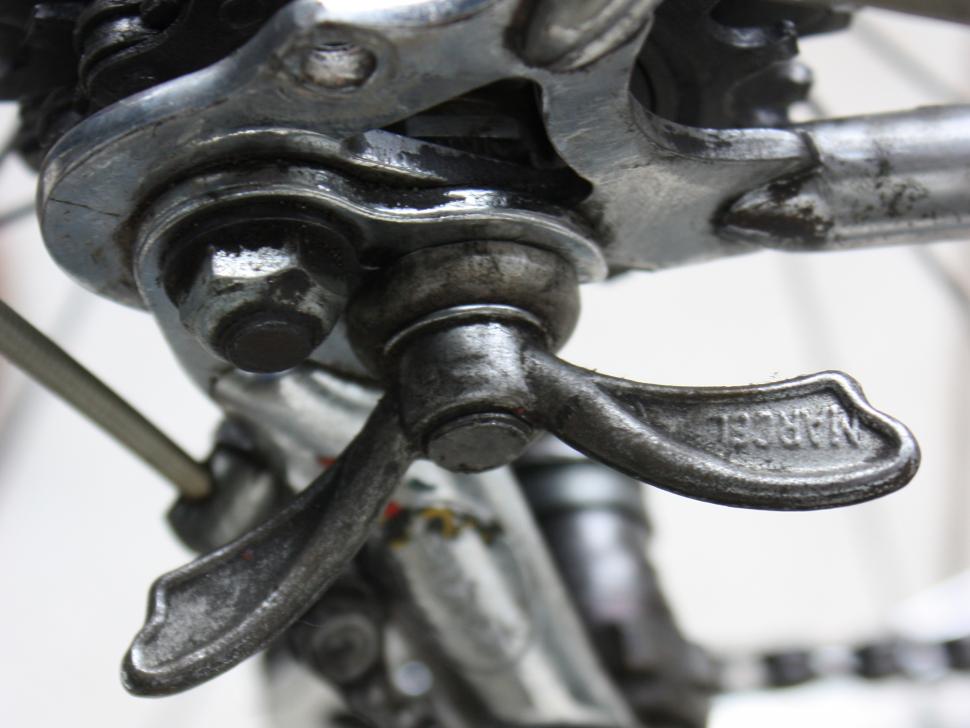
Add new comment
58 comments
I would agree with every one of the unmourned technologies listed here with one exception: downtube shifters.
In their place I would suggest 'single pivot' (not that I recall that term being used at the time) brake calipers. I'm happy to have DT shifters on three of my bikes including the flat-barred tandem (the only one that's indexed - except the front, of course). Equally, I wouldn't want to give up the STIs on my other bikes. But DT shifters just work and a prang involving the brake lever doesn't put an (expensive) end to your ride.
Dual pivot calipers are a huge improvement on their predecessors - and the reason there's really no need for disc brakes on my road bikes, of course.
Bar end shifters on my Dawes Galaxy. When climbing hills, standing on the cranks, my knee would hit the shifter thereby moving up one or two sprockets at the most inappropriate time.
Personally love my downshifters (indexed 10 speed). Simple, reliable, and positioned out of harms way. Perfect for touring. That they're branded Dura Ace doesn't hurt...
Totally agree! For touring and even grand fondos, down tube shifters are fine. For serious racing they are no match for STI, but for reliability and riding along with friends on your road bike, they will do just fine. Nothing wrong with the technology, just not as fit for competition as STI.
Steel rims would be perfectly sensible for uses where robustness is more important than weight, like a commuter or cargo e-bike. Obviously you'd want to use discs with them, though. And probably stainless rather than chromed.
I remember (cheep) steel rims, they used to buckle with depressing regularity on hitting potholes. I was forever buying new wheels back in the 80s.
They were only rolled sheet steel, so they were never robust... 'flimsy' would be a better description.
Whilst largely agreeing with this article, I must point out that cottered cranks are no way as problematical as presented; at least you don't need specialist tools to get them off, AND the cotter pins themselves do NOT need filing/fitting at all; if assembled correctly there's no play and, so long as their fitted with a shakeproof washer, simple tightening of the cotter nut is sufficient. So you've no need to possess a socket set to apply a massive torque to the retaining nut as you need for cotter less cranks. I'll admit I have 4 bikes, all refurbished British made steel frames and the original cottered cranks have all been replaced with cotter less; this is because the originals were chromium plated steel and that's 'the why'!
I would add that I'd never touch stainless steel spokes, even the beefed up 'Alpine' ones, if galvanized spokes get brittle with age/use, I've never experienced it; SS spokes are brittle from day one and break at the least provocation, especially at the plain 'lug' end and the thread!
It takes all sorts, doesn't it?
Scarey.
If you rode a bike in the 60s and 70s, you'd soon recognise the regular clunk of a worn cotter pin. That was a bike shop problem to sort, which made them something to tolerate because the bikes were not worth spending money on. Like square tapers, if you damaged the fitting, you were never going to get it pinned properly without replacing parts.
No they don't. Pretty much all spokes these days from eg Sapim, DT Swiss, are stainless steel and they are highly reliable. I've built plenty of wheels and broken spokes are really rare.
I wonder why the cotter pin?
Presumably a combination of adapting engineering from larger scale fixings and the ease of engineering a cotter pin as opposed to the complexity of square tapers and the toothed arrangements of today.
I guess every now and then everything needs looking at to ask the question "Is this really the best way to do things?"
You need a special tool for square taper cranks.
The cotter pin allowed for much "looser" tolerances.
I'm quite sure that the cotter pin arrangement would not have been unusual to an average engineer 150-200 years back.
Didn't your average engineering use those half-moon keys? They fitted in a semicircular cutout in the shaft and adjusted to the angle of the matching cut in the pulley or sprocket. I remember them from my early motorbikes, and you always see them on old cast iron cogs and pulleys. They needed locktite or the torque would chew them up in no time.
The cotter is a very ancient device, pretty much pre dating mass produced metal items (in wooden implements even), from a practical point of view, when cycling became popular in the 19th century, cotters would have been the only way of cheaply fixing cranks. And don't forget people expected to maintain and repair their own bikes, so sockets, special extractors and torque wrenches were a no no anyway.
Having lived with some of these technologies, the worst was by far the steel rims, combined with long reach brakes. Braking was a result of prayers, hope and calculation. Downtube shifters were either not very pleasant experience, I do accept that brifters was a game changer.
Cottered cranks were deeply flawed, but square-tapered still has a similar flaw: The torque of pedalling tries to shift the cotter pin which makes it work loose, unless you've tightened it perfectly. Square tapered cranks are fine at first, but once it's worked loose once, it'll keep on happening unless you get it just right (not easy to do when you're at the roadside); the faces can get chewed up a little and the taper causes a varying axial force on the retaining bolt so that can work loose too.
Splined interfaces (including Hirth joints if the teeth are the right shape) sidestep that neatly; force is transmitted between two pieces of metal which meet on a plane orthogonal to the force, it doesn't try to flex some kind of retaining bolt with every cycle. Splines are awesome. They're just a bit harder to machine so it took a long time for them to become dominant in mass-market bikes; it's hardly the kind of improvement that customers notice on the shop-floor of Halfords.
I still see a few cotters when repairing cheap kids' bikes. To be fair, it's easy for any parent to tighten that bolt, and no 4-year-old is going to push very hard on the cranks (or get stranded far from home). I assume there's a factory in China somewhere that's still using tooling from 1960 and they can't cost-justify replacing it.
Square tapers come loose if they're poorly manufactured or not fitted tightly enough. I remember being really surprised by how much oomph they needed when I first used a torque wrench on a bike.
Once they've come loose, the problem is that the inside of the taper in the crank immediately gets damaged and no longer fits the axle, and there's basically nothing you can do about it. I've seen people claim to have filed them so they subsequently fit. I'm deeply sceptical!
I'm a failed filer but a shim from an old can wrapped around the taper can work for years!
It's not 'brifters' that made geared bikes accessible for the big public, but SIS. Before Shimano's HyperGlide cassettes you had to 'over shift' a bit to get the chain to make the shift to the next sprocket, and then trim it back a bit to get the chain in line with that sprocket. The intricate shaping of the HyperGlide cassettes teeth made that over shifting was no longer neccesary, and that opened the way to indexed shifting. Shimano Index Shifting, SIS, was what made shifting so easy that even novices could use gears, without a learning curve.
Shimano heavily patented that of course, so other brands struggled and lost the battle for the big public there. SunTour, Sachs, Campagnolo to a big degree, they all lost serious ground there and never really recovered. Then Shimano came with Shimano Total Integration, STI, combining shifters and brake levers, making the whole drivetrain a system that worked together, and that was another huge blow for many other brands that made brakes, cranks, chain rings, cassettes, chains etc.
TL;DR: it's not brifters that made down tube shifters obsolete, but SIS. Brifters were just a logical next step.
BTW, friction shifting still has some advantages that make it a better choice for certain people and usages.
I'm fairly sure that my last "racer" (destroyed by incompetent motorist in '92) had indexed down tube shifters.
The road bike I bought in about 1992 had seven speed indexed down tube shifters. STI existed, but was out of my price range.
I still have the bike, currently with 10 speed 105.
That's 10 speeds on the rear cassette of course, not like my previous (friction shift, freewheel) bike with 2x5.
The thing I really notice when moving between brifters or MTB shifters and down-tube levers is how awful the latter are in traffic. A bit ironic that race-driven tech turns out to be so handy for utility cycling.
Out on the open road, I still find it a bit of an effort reaching past my gut to get to the levers, but it's really not much of a problem. And talk about future-proof - the levers and derailleurs designed for 2x5 still work very nicely on 2x10. Lovely SunTour kit from when they were lighter and better than Shimano and a country mile ahead of Campag. IMHO of course.
It's a shame SunTour are not credited with the slant parallelogram RD, they remain some of the best ever made. I'm happily still using DT friction shifting (Simplex Retrofriction), 6 and 7-speed freewheels (SunTour) and wingnuts (GB).
This article conflates galvanised spokes with poor quality steel, as if only poor quality steel spokes were galvainsed, then conflated stainless steel spokes with good quality steel; laughably incorrect, as I've got 30 year old mtb with the original galvanised spoke wheels still in great nick and my bike mechanic mate has seen numerous poor quality stainless spokes fail prematurely..
Meh. Lived through many of these; still running down-tube shifters, screw-on freewheels... and I'd probably take wingnuts too on some bikes. Especially once I figure out how to use e.g. a bike lock for extra leverage.
Certainly for the things above if you can still find parts (you can) and don't race / need to subscribe to some particular discipline (downhill underwater gravel bikepacking) there aren't really issues.
On the other hand, there's no particular reason (aside from reduce, reuse) for deliberately avoiding some of the alternatives. Well, maybe more than 9 cogs at the back is excessive. After all who's running Everready bike lights now? I'm starting to relax into the happy middle ground of 'outmoded by current standards" yet much improved from "when I were a lad". So the odd disc brake here, sealed bottom brackets (convenience), a 10 speed there (yeah - who cares about consistency?)
My sentiments exactly. If good enough is cheap enough then you've hit a happy medium.
Anyone who only wants to have one size of spare chain waiting for whichever bike needs it next, and/or to be able to swap components between bikes. But I've rather given up on that as a goal, though I will probably upgrade my remaining 7-speed bike (possibly to hub gears) before anything goes to 11.
Yes - and as someone with a bike with a loooong chain that is a thing. Crossed that rubicon already though.
Was loving my new Alfine 8 until it disappeared with the bike it was on. Once relearned technique I only had one or two "gear change farts" - probably due to not having stopped my legs going round quickly enough. For transportation and pottering it turned out I didn't miss the extra range of my triple. Was contemplating lowering the whole range for the odd heavier cargo mission. The input ratio as supplied with bikes with hub gears always seems "conservative" e.g. rather tall - is it they think most people don't spin or worries about getting near the manufacturer's max torque?
Suicide levers were great because you could throw them away and instantly get a better looking and better braking bike. I'm sure that was my first ever modification although it could have been clingfilm on the rear rack as the shortie mudguards did nothing.
Anyway it made 10 year old me feel like a TDF mechanic until the next time I had to fix a puncture with my mums tea spoons.
As for downtube levers, probably the best upgrade in riding pleasure I've ever experienced was changing my old steel Raleigh 10 speed friction levers to 105 14 speed (still on the downtube though) along with my first custom built wheel.
Just because dustbins and spokes can both be galvanised doesn't mean that they are made of the same grade of steel. Stainless spokes (and cables) are weaker than the 'rustless' alternatives, at least until they have rusted. There should be no need to hammer or file cotter pins unless they need replacing. I'm not saying we should go back to using them (well maybe in preference to Sram) but they have an unfairly bad reputation from being bodged.
Pages